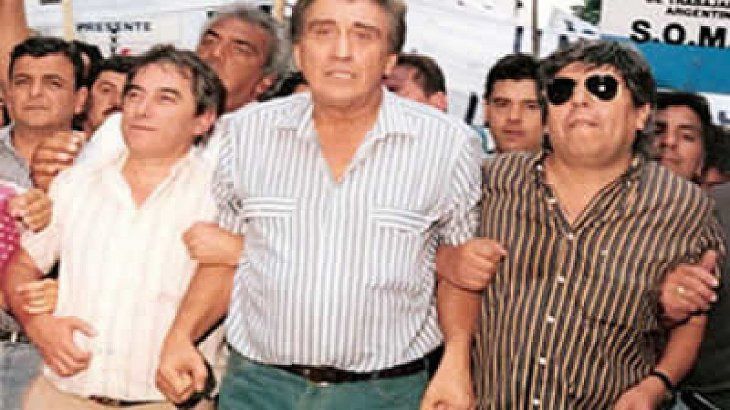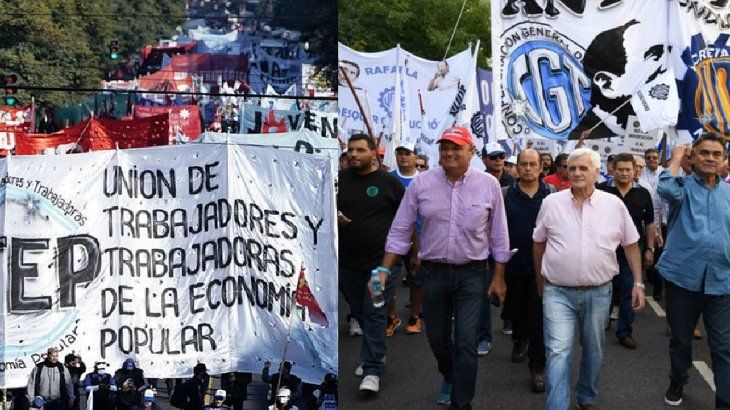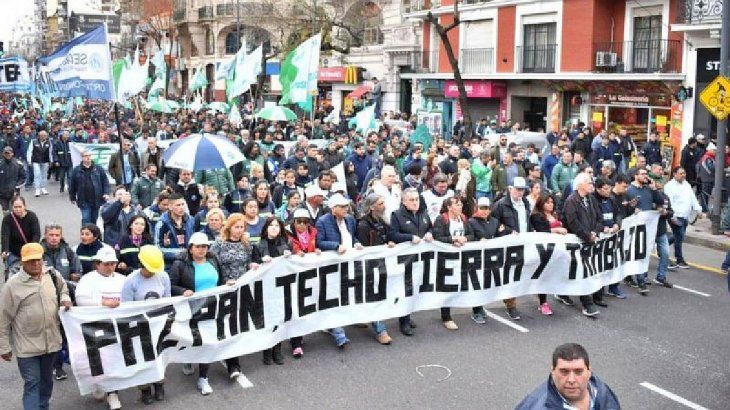when he was overthrown Juan Domingo Peron In the 1955 coup d’état, the first thing the military did was intervene in the unions.
The following dictatorial and democratic governments that succeeded them until 1973 were pendulum in the relationship with the unions, due to the strong organized resistance of the unionized workers.
We are witnessing the alternation between repressing, imprisoning and torturing, with the cession of rights. Even in trying to “Co-opt them”, agreed in the face of some demands, in force today.
The working people, always astute, advanced in the possible improvements while keeping intact the fundamental slogan: “Peron is back”. I knew that it could only develop and be part of a national liberation project with Perón, who synthesized that improvement project for the entire group.
Mobilization against the dictatorship.jpg
The coup of the year ’76, in light of what was learned, tried to give the final blow to these structures, but again met with strong resistance. The data is compelling: 67 percent of the disappeared were workers.
The aim was to break union activism, penetrating its organizational structure. The genocidal dictatorship could not, but it left a great fracture within the popular field that until today we workers suffer.
When democracy returned in 1983, and the horror was over, Alfonsín, the first post-dictatorship president, just days after his inauguration on December 10, 1983, presented the draft “Trade Union Reorganization Law” drawn up by his minister of Job, Antonio Mucci. The initiative encountered strong resistance from trade union organizations, and was finally rejected in the Senate. In other words, the labor movement tortured, imprisoned and murdered, and for which, thanks to its resistance, it was one of the protagonists to recover democracy, found itself, almost unable to reorganize itself and watch over its dead in peace, with a new onslaught “democratic”, whose purpose was the same, to break the union structure.
Saúl Ubaldini.jpg

The new attempt came from the hand of the liberalism of the ’90s installed in the Casa Rosada, which sought to complete what was started by the last dictatorship. The total destruction of the productive structure of the country and its labor and social consequences that ensured that it can never be rebuilt again, and then the mini-government of the Alliance with Fernando De la Rua and his attempts to labor reforms.
Ubaldini Moyano.jpg

With Nestor Kirchner trade unionism recovered space and rights. But the country was already another. The arrival of macrismo redoubled the preaching on the demonization of union leaders. Intelligent strategy, which seeks in the personalization of a leader the destruction of the entire union model.
Through crude logical fallacies, they repeated “such a trade unionist is bad, all trade unionists are bad.” And so we find interventions and raids carried out on several unions (obviously not randomly or for real reasons), in which the “controllers” tried to break them economically (the case of Macri’s former labor minister, Jorge Triaca is the most resounding and the most unpunished). Meanwhile, in a parallel way, they advanced in the destruction of what remains of the productive model of the country, benefiting the great national and foreign capitals, and indebting Argentina in an insane way, with the aim of burying us in an eternal dependency. This happened on the side of real power, but it is always good to look at ourselves.
The macrismo “achieved” through fear that union unity was achieved. And even more, progress was made in a us Wider, adding to the popular movements that seek to organize the workers of the popular economy.
UOM UTEP.jpg

In collective discernment, some of us wonder if this is not a pivotal moment in our time, -especially after an unprecedented global pandemic and an unprecedented advance in technology-, to translate that unity into something that crystallizes beyond the frights conjunctural.
Isn’t it time for all of us, leaders and activists of the second, third and even fourth lines, to stop counting our ribs and reach a consensus of unity based on a few points of agreement, beyond disagreements?
Together for Change was so brutal that the merry-go-round crashed and was exposed in a bestial way. But we know that macrismo is nothing more than the political representation of the interests of the true economic power. The same one who at the time used weapons to impose his interests and who would be willing to use them again.
What if the macrismo that comes is not so obvious?
The opposition managed to win the mid-term elections last year, shouting in the last days of the campaign that they had to end compensation, among other rights. He won by shouting that, among other barbarities.
It is not a minor fact to take into account, that for many years compensation ceased to be something usual for a large part of our population, and especially for workers. Why would they defend her?
Destroying the Argentine union model is an obsession of yesteryear. We did not discover anything new. What is new is how we are going to stop it, and how we advance in improving this trade union model to advance in the conquest of rights for all workers in the country.
To continue talking about the organized labor movement is to refer to another time when the labor structure was different.
Social Dialogue CGT UTEP Iglesia.jpg

How do we make young workers understand the importance (beyond their individualism) of having a strong union model?
How do we build a workers’ movement that contains us all?
How do we include unregistered workers, the self-employed and those from the social and popular economy (cooperatives and independents), so as not to give that conception to that same “macrismo” that so vindicates and “empowers” it, but with totally opposite intentions? to the interests of those same workers? Or perhaps someone considers it credible that we will all be entrepreneurs or our own bosses.
The document prepared by the CGT in its last congress, entitled “GOING BACK TO WORK AS THE GREAT SOCIAL COMPUTER”, is an excellent starting point to put into practice what we propose here.
Peace Bread Land Roof and Work.jpg

Finally, we believe it is necessary to rescue a Jesuit priest, Jacinto Luzzi, who wrote in 1981 about his experience with union leaders, whom he called: “Argentine Trade Unionism makes a path by walking”; where he reflects on the two permanent trends in union history: those who negotiate and those who confront; emphasizing that they always existed, always complemented each other and were always necessary.
About the end, he expresses: “Commit to the bottom line already in the realization of a trade unionism capable of responding to the needs of the time and its circumstances. Today the future is built. In order to avoid any stagnation, in this commitment the leader must be open to criticism and self-criticism. This also applies to the basic attitudes indicated in the history of trade unionism, negotiation and confrontation. When polarized, those attitudes easily become personal issues. These positions must be abandoned. Confrontation and negotiation are mere tools whose validity depends on the purpose for which they are used, that is, what is being negotiated or confronted for. Argentine trade unionism makes its way by walking, and you can’t walk jumping on one leg. Both attitudes are necessary to walk.“
MOBILIZATION.jpg

Image: Argentine News.
Source From: Ambito




